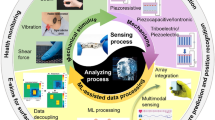Abstract
Machine learning methods have been proven to be a useful and powerful mechanism in classification problems and pattern recognition. It is possible to classify into different categories on the basis of a training set of data through a discrete number of characteristics and without knowing the whole intrinsic information. For that, those methods are widely extended to address Activity Recognition. One of the limitations of traditional machine learning methods is the need of a large training dataset to get an effective model with high accuracy levels. This issue is the main motivation of the present work that proposes the named Extended Body-Angles Algorithm, a method able to recognize movements through single samples of modelled movements using Kinect. Their functioning is based on the Body-Angles Algorithm. This manuscript deepens into the detection of postures (Body-Angles Algorithm) that has been generalized to movements (Extended Body-Angles Algorithm), describing also the results of the algorithm evaluation.













Similar content being viewed by others
References
Alexiadis DS, Kelly P, Daras P, O’Connor NE, Boubekeur T, Moussa MB (2011) Evaluating a dancer’s performance using kinect-based skeleton tracking. In: Proceedings of the 19th ACM international conference on multimedia. ACM, Scottsdale, Arizona, USA, pp. 659–662
Bansal S, Khandelwal S, Gupta S, Goyal D (2013) Kitchen activity recognition based on scene context. In: International conference on image processing (ICIP). IEEE, Melbourne, pp 3461–3465
Biswas KK, Basu SK (2011) Gesture recognition using Microsoft Kinect®. In: Automation, robotics and applications (ICARA) 5th international conference. IEEE, Wellington, pp 100–103
Boger J, Hoey J, Poupart P, Boutilier C, Fernie G, Mihailidis A (2006) A planning system based on Markov decision processes to guide people with dementia through activities of daily living. IEEE Trans Inf Technol Biomed 10(2):323–333
Brush A, Krumm J, Scott J (2010) Activity recognition research: the good, the bad, and the future. In: Pervasive workshop how to do good research in activity recognition, Helsinki, Finland (2010)
Dey AK (2001) Understanding and using context. Pers Ubiquit Comput 5(1):4–7
Fontecha J, Navarro FJ, Hervás R, Bravo J (2013) Elderly frailty detection by using accelerometer-enabled smartphones and clinical information records. Pers Ubiquit Comput 17(6):1073–1083
Fu J, Liu C, Hsu YP, Fu LC (2013) Recognizing context-aware activities of daily living using RGBD sensor. In: IEEE/RSJ international conference on intelligent robots and systems (IROS). IEEE, Tokyo, pp 2222–2227
Goncalves N, Costa S, Rodrigues J, Soares F (2014) Detection of stereotyped hand flapping movements in Autistic children using the Kinect sensor: a case study. In: Autonomous robot systems and competitions (ICARSC). IEEE, Espinho, Portugal, pp 212–216
Gutiérrez López de la Franca C, Hervás R, Bravo J (2015) Activity recognition in intelligent assistive environments through video analysis with body-angles algorithm. In: 9th international conference on ubiquitous computing and ambient intelligence (UCAmI). Springer, Puerto Varas, pp 162–173
Hervas R, Bravo J, Fontecha J (2014) An assistive navigation system based on augmented reality and context awareness for people with mild cognitive impairments. IEEE J Biomed Health Inform 18(1):368–374
Ladha C, Hammerla N, Hughes E, Olivier P, Plötz T (2013) Dog’s life: wearable activity recognition for dogs. In: Proceedings of the ACM international joint conference on Pervasive and ubiquitous computing. ACM, Zurich, pp 415–418
Leightley D, Darby J, Li B, McPhee JS, Yap MH (2013) Human activity recognition for physical rehabilitation. In: IEEE international conference on systems, man, and cybernetics (SMC). IEEE, Manchester, pp 261–266
Ramirez-Giraldo D, Molina-Giraldo S, Alvarez-Meza AM, Daza-Santacoloma G, Castellanos-Dominguez G (2012) Kernel based hand gesture recognition using kinect sensor. In:XVII symposium on image, signal processing, and artificial vision (STSIVA). IEEE, Antioquia, Turkey, pp 158–161
Raso I, Hervás R, Bravo J (2010) m-Physio: personalized accelerometer-based physical rehabilitation platform. In: Proceedings of the fourth international conference on mobile ubiquitous computing, systems, services and technologies, Florence, Italy, pp 416–421
Ryoo MS, Matthies L (2013) First-person activity recognition: what are they doing to me? In: computer vision and pattern recognition (CVPR). IEEE, Portland, pp 2730–2737
Tapia EM, Intille SS, Larson K (2004) Activity recognition in the home using simple and ubiquitous sensors. In: Ferscha A, Mattern F (eds) Pervasive computing. LNCS, vol 3001. Springer, Berlin, pp 158–175
Veltmaat MJT, van Otterlo M, Vogt J (2013) Recognizing activities with the Kinect. Technical report, Radboud University Nijmagen
Yang Z, Zicheng L, Hong C (2013) RGB-depth feature for 3D human activity recognition. China Commun 10(7):93–103
Acknowledgements
This work was conducted in the context of UBIHEALTH project under International Research Staff Exchange Schema (MC-IRSES 316337) and the coordinated Project Grant TIN2013-47152-C3-1-R (FRASE), funded by the Spanish Ministerio de Ciencia e Innovación.
Author information
Authors and Affiliations
Corresponding author
Rights and permissions
About this article
Cite this article
Gutiérrez López de la Franca, C., Hervás, R., Johnson, E. et al. Extended Body-Angles Algorithm to recognize activities within intelligent environments. J Ambient Intell Human Comput 8, 531–549 (2017). https://doi.org/10.1007/s12652-017-0463-y
Received:
Accepted:
Published:
Issue Date:
DOI: https://doi.org/10.1007/s12652-017-0463-y




